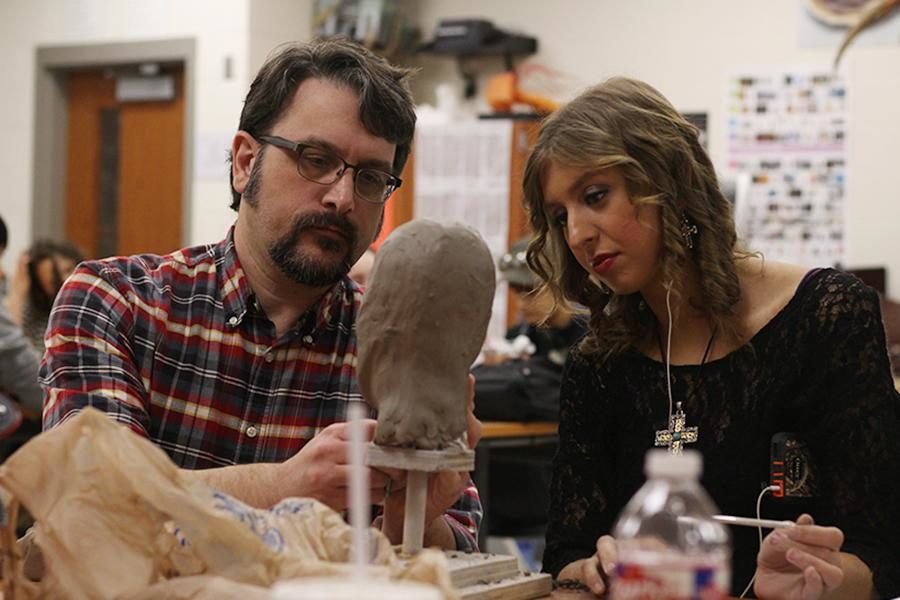Teachers by day, working artists by night
The art teachers that occupy E hall are not only teaching students, but also selling their personal art
Mr. Seidel lends a helping hand to sophomore Jacquelyn Albers.
February 26, 2016
Art lovers seek out artists to commission pieces for them. The client gets to work with the artist to come up with a body of work that both the artist is able to create and that the client wanting. Art teachers Amanda Beller, Brice McCasland, and Jeff Seidel have been selling commissioned work for years.
“[In my work,] I feel like I can say things that aren’t just whispers, and that aren’t just whim, and that these things that are said, even if the story changes down the line, it’s still more permanent than other things,” McCasland said. “It’s very hard to describe. It’s one of those things that I think that, if you love something greatly, then you can never describe it.”
While each teacher studied art as their major in college, none of them envisioned teaching as being a part of their future career initially.
“I didn’t take art in high school because we had one teacher and he was a cartoonist, so I just did art on my own,” Beller said. “I really didn’t have much formal training in art until college. I was a double art major, so it allowed me to take a lot of courses that were maybe more unusual.”
Each teacher started doing commission work soon after graduating from college, either for money or as a vessel to share their creativity.
“I thought I was originally going to do my own work, but when I started substitute teaching because I needed money I realized that was kind of my passion,” Seidel said. “I did commission work on the side either to help people out or to make extra money.”
The art teachers used their natural skills and training to facilitate their passions to teach.
“I don’t teach art because it’s a sweet gig, I teach it because I don’t know how I can deal without it,” McCasland said. “When I didn’t teach and I just painted, something was missing in that whole spectrum, because I love the aspect of helping. I feel like what I get to do every day is very similar to working with people on a commission where I am hashing out ideas and helping people find this clear vision of what it is that they want to say.”
Clients normally come to the artists with an idea of either what they want the work of art to look like or what they want the piece to mean. The artist takes on the role of transforming those ideas into a tangible body of work that perfectly communicates the client’s intent.
“The most entertaining part about commission is that collaborative process where they have an idea and then you come up with sketches and show it to them,” Seidel said. “Then you kind of bounce back ideas back and forth until you finally have a vision, and then you finally have a clear like a really narrow target to hit.”
The teachers used their resources to build up a network of buyers. While some clients only work with the artist to create one piece, others are repeat customers who frequently buy from the artist.
“I went to school in the dark ages when we didn’t have social media so I would sell mostly to family and friends who saw my work or at art shows at school at the university,” Beller said. “Then, I’ve done several art festivals that I’ve sold stuff or even followed up with commissioned work and I post things on the internet [or] social media.”
As artists, the teachers transition between styles as their interests change. When working with commissioned work, they can sometimes encounter requests for pieces out of their comfort zone or pieces that are not in their current style.
“Usually, the people that come to me often aren’t people that buy commission work,” McCasland said. “They’re people that follow my bodies of work, so they don’t want something that they come up with, they want something that I come up with. The people that continue to buy my work they like to see that shift or the growth or the change in my work.”
Seidel attributes the personal confidence he has in his work to his commission experience. His mindset about his work changed as he sold more pieces.
“I think you start to put more value in your own work [when you sell commissions] because when I first started doing them I charged next to nothing,” Seidel said. “The more money I made, the more I realized that people actually valued what I did and so I think that’s my mindset is the biggest change.”
The teachers agreed that if they are offered a job that doesn’t showcase their talents the best and could be better done by someone else, they recommend their colleagues to the client.
“I tend to kind of take commissions as a challenge a little bit and I don’t really back down from challenges very well, so if somebody asks if I could do this I tell them like ‘yeah I could,’” Beller said. “I guess it’s hard for me to say no to commission stuff unless it’s just really lame.”
McCasland puts a sense of worth into his bodies of work because they mean more than a reputation to him.
“People say all that time that your job doesn’t define you or your art doesn’t define you, and I don’t know that I can say that,” McCasland said. “I feel like part of me is definitely defined by what I do and I feel like those things are going to live longer than I will, and so I take great care in the things I create with my hands because it’s those things that will last.”




